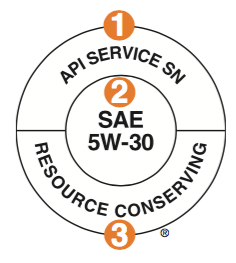API’s Certification Mark and Service Symbol identify quality motor oils for gasoline- and diesel-powered vehicles. Oils displaying these marks meet performance requirements set by U.S. and international vehicle and engine manufacturers and the lubricant industry. More than 500 companies worldwide participate in this voluntary program, which is backed by a marketplace sampling and testing program.
The API Certification Mark, also known as the “Starburst”
An oil displaying this mark meets the current engine protection standard and fuel economy requirements of the International Lubricant Specification Advisory Committee (ILSAC), a joint effort of U.S. and Japanese automobile manufacturers. Automobile manufacturers recommend oils that carry
the API Certification Mark. See the ILSAC STANDARD FOR PASSENGER CAR ENGINE OILS chart on the next page for descriptions of current and obsolete ILSAC standards.

The API Service Symbol, also known as the “Donut”
1. Performance Level
Motor oils designed for cars, vans, and light trucks with gasoline engines fall under API’s “S” (Service) categories. Motor oils designed for heavy- duty trucks and vehicles with diesel engines fall under API’s “C” (Commercial) categories. Please see the Gasoline Engines and Diesel Engines charts on the next pages for descriptions of current and obsolete API service categories.
2. Viscosity Grade
The measure of an oil’s ability to flow at certain temperatures. Vehicle requirements may vary. Follow your vehicle manufacturer’s recommendations on SAE oil viscosity.
3. Resource Conserving and Energy Conserving
These designations apply to oils intended for gasoline-engine cars, vans, and light trucks. Widespread use of “Resource Conserving” or “Energy Conserving” oils may result in an overall savings of fuel in the vehicle fleet as a whole.
